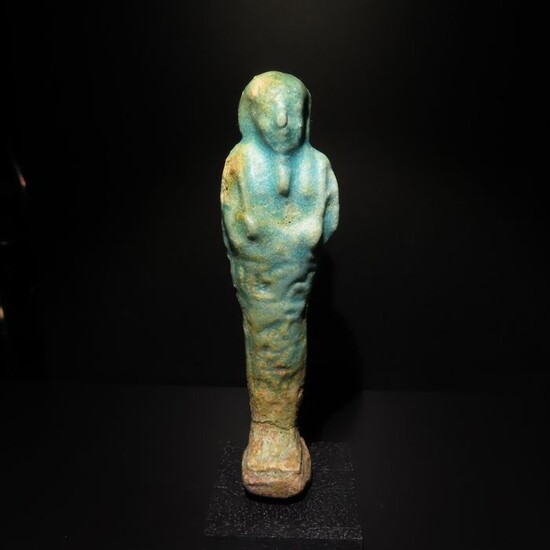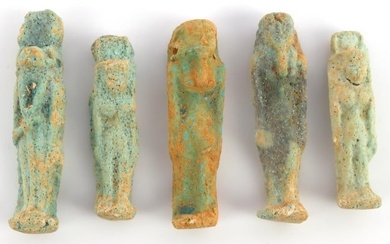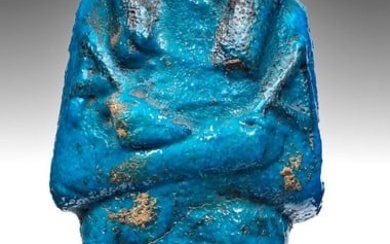Ancient Egyptian Faience Ushabti for HOR - KHONSU. Late Period, 664 - 323 BC. 10,7 cm H.
Ushabti for HOR - KHONSU Ancient Egypt, Late Period, 664 - 323 BC MATERIAL: Faience SIZE: Height 10,7 cm PROVENANCE: Private collection, London, acquired in 1970s. CONDITION: Good, breakline in the end of the legs rejoined. The faience shabti has a T-shape inscription and fine modelled details of the face, the plaited beard, striated tripartite wig, hands and hoes. The figure has a pedestal and a back pillar. These features indicate that the shabti dates to the 4th or the 3th cent BC (30th dynasty/Ptolemaic period) The inscription reads as follows: (1) s. HD Wsir sms (2) Hr-xnsw ms(n) MAat-wr(t) (1) Illuminating of Osiris, the Sem priest/Eldest (2) Hor-Khonsu, born of Maat-wer(et) Hor-Khonsu is a typical name for the Late period of Ancient Egypt (see Ranke, Personennamen, p. 250 Nr. 12) The inscription mentions the title of a Sem priest or Eldest . In both cases, Hor-Khonsu held a high priestly office. The Egyptian Afterlife was understood as a mirror of the real world, where both good and evil had their place. Those who were unfair or evil were punished for eternity, while the just enjoyed a comfortable existence travelling with the solar god. Even then, the deceased who were so blessed were still obliged to fulfil human responsibilities and needs, in the same way they had to in life. Their need to have food and drink in the Afterlife was a constant worry for them. If they were obliged to work in the Fields of Aaru, in the Realm of the Dead, and as members of a society which was a hierarchy governed by the gods, everyone – men and women, lords and servants, kings and queens – had to be willing to cultivate, sow and harvest the crops. In the world of the living these basic tasks of production were carried out by the lower classes in society. To avoid this fate, Egyptians looked for a magic solution: they created one or more figures of themselves to be able to hand over to the emissaries of the reigning god, Osiris, when these called on the deceased to fulfil his obligations. These statuettes, placed amongst the grave goods in the tomb, were images which represented both the master and the servant. They are known by the name of ushabtis, the term coming from sabty or shabty, derived from Sawab, the meaning of which corresponds to the Greek word “persea”, a sacred tree from whose wood the ancient Egyptians began to produce these funerary effigies. It was towards the Third Intermediate Period, in Dynasty XXI, around 1080 BC when they began to use the term wsbty, that is, “ushebty”. From then on the name “ushabti” derived from the verb wsb meaning “to answer” was used to name “he who answers”. The use of ushabtis was incorporated into the burials in Ancient Egypt from the First Intermediate Period on. Their use grew during the Middle Kingdom, the time when the Egyptians began to write a spell in the Coffin Texts, number 472, so that the ushabtis would answer to the call: “The justified N. says ‘Oh ushabti, allotted to N, if N is summoned to do any work, or if a disagreeable task was asked of N as for any man for his duty, you are to say ‘I am here’. If N is called to watch over those who work there, ploughing the new fields to break the earth, or to ferry sand in a boat from east to west, you will say ‘I am here’. The justified N. ” This spell or utterance went on to be inscribed on ushabtis, and so in most cases, it appears there engraved. From the New Kingdom on, a great number of innovations were introduced. Examples with texts started to proliferate. Some of these were somewhat longer texts from Chapter VI in the Book of the Dead. Even so, in many cases the text simply indicates the name of the deceased, or a basic utterance, with the name of a family member or the posts that he held. Ushabtis at first were made above all from wax, later from wood, and then towards the end of the Middle Kingdom they appeared in stone. From the New Kingdom on, the material par excellence was faience. We know they were produced in multiples thanks to moulds which have been preserved, and where in some cases, the engraved texts were unfinished, as the name of the owner was missing. The most popular form was that of the mummy until the introduction, towards the end of Dynasty XVIII, of figures decorated with everyday clothing. Many carried implements to work in the fields, such as a basket, a hoe or a pick, as a reference to the task to be carried out which was awaiting them in the Afterlife, as the symbolic representation of their master. The iconography, texts, materials, colours and their placing in the tomb could suggest other symbolic meanings. Sometimes they were placed in wooden boxes, which could be either simple ones or with sophisticated decoration. In the New Kingdom they came to be placed in miniature sarcophagi. While at first they were considered to be replicas of the deceased, in the New Kingdom and later, the ushabtis came to be seen as servants or a manner of slave, and for this reason they were produced en masse. There were both women and men, including specialists in different activities. Sometimes they were under the supervision of overseers, and these were distinguished by the use of a kilt. This is the case for the pharaoh Tutankhamun: he had three hundred and sixty five ushabtis at his command, one for each day of the year; thirty six overseers, one for each team of ten workers; and twelve master overseers, one for each month of the year. This came to a total of four hundred and thirteen servants in the Otherworld. The fear of having to carry out these tasks demanded of the dead by Osiris meant that in some burials there were even ushabtis who were there to act as substitutes or stand-ins, if necessary, for the main ones. It is logical to think that no pharaoh would have wanted to carry out this type of task personally, and so at the necessary moment the utterance written on the body of the ushabti was read out so that this object acquired life to answer to the call, substituting for the pharaoh in the work. Notes: The seller guarantees that he acquired this piece according to all national and international laws related to the ownership of cultural property. Provenance statement seen by Catawiki. The seller will take care that any necessary permits, like an export license will be arranged, he will inform the buyer about the status of it if this takes more than a few days. According to Spanish legislation, items sent outside the European Union are subject to export taxes and will be added to the invoice, at the buyer's expense. These export fees are fixed on the final auction price and the tax rate is not applied directly on the total value of the item to be exported, but rather the different percentages by sections are applied to it: - Up to 6,000 euros: 5%. - From 6. 001 to 60. 000 euros: 10%. This export permit application process can take between 1 months maximum.
[ translate ]View it on
Estimate
Time, Location
Auction House
Ushabti for HOR - KHONSU Ancient Egypt, Late Period, 664 - 323 BC MATERIAL: Faience SIZE: Height 10,7 cm PROVENANCE: Private collection, London, acquired in 1970s. CONDITION: Good, breakline in the end of the legs rejoined. The faience shabti has a T-shape inscription and fine modelled details of the face, the plaited beard, striated tripartite wig, hands and hoes. The figure has a pedestal and a back pillar. These features indicate that the shabti dates to the 4th or the 3th cent BC (30th dynasty/Ptolemaic period) The inscription reads as follows: (1) s. HD Wsir sms (2) Hr-xnsw ms(n) MAat-wr(t) (1) Illuminating of Osiris, the Sem priest/Eldest (2) Hor-Khonsu, born of Maat-wer(et) Hor-Khonsu is a typical name for the Late period of Ancient Egypt (see Ranke, Personennamen, p. 250 Nr. 12) The inscription mentions the title of a Sem priest or Eldest . In both cases, Hor-Khonsu held a high priestly office. The Egyptian Afterlife was understood as a mirror of the real world, where both good and evil had their place. Those who were unfair or evil were punished for eternity, while the just enjoyed a comfortable existence travelling with the solar god. Even then, the deceased who were so blessed were still obliged to fulfil human responsibilities and needs, in the same way they had to in life. Their need to have food and drink in the Afterlife was a constant worry for them. If they were obliged to work in the Fields of Aaru, in the Realm of the Dead, and as members of a society which was a hierarchy governed by the gods, everyone – men and women, lords and servants, kings and queens – had to be willing to cultivate, sow and harvest the crops. In the world of the living these basic tasks of production were carried out by the lower classes in society. To avoid this fate, Egyptians looked for a magic solution: they created one or more figures of themselves to be able to hand over to the emissaries of the reigning god, Osiris, when these called on the deceased to fulfil his obligations. These statuettes, placed amongst the grave goods in the tomb, were images which represented both the master and the servant. They are known by the name of ushabtis, the term coming from sabty or shabty, derived from Sawab, the meaning of which corresponds to the Greek word “persea”, a sacred tree from whose wood the ancient Egyptians began to produce these funerary effigies. It was towards the Third Intermediate Period, in Dynasty XXI, around 1080 BC when they began to use the term wsbty, that is, “ushebty”. From then on the name “ushabti” derived from the verb wsb meaning “to answer” was used to name “he who answers”. The use of ushabtis was incorporated into the burials in Ancient Egypt from the First Intermediate Period on. Their use grew during the Middle Kingdom, the time when the Egyptians began to write a spell in the Coffin Texts, number 472, so that the ushabtis would answer to the call: “The justified N. says ‘Oh ushabti, allotted to N, if N is summoned to do any work, or if a disagreeable task was asked of N as for any man for his duty, you are to say ‘I am here’. If N is called to watch over those who work there, ploughing the new fields to break the earth, or to ferry sand in a boat from east to west, you will say ‘I am here’. The justified N. ” This spell or utterance went on to be inscribed on ushabtis, and so in most cases, it appears there engraved. From the New Kingdom on, a great number of innovations were introduced. Examples with texts started to proliferate. Some of these were somewhat longer texts from Chapter VI in the Book of the Dead. Even so, in many cases the text simply indicates the name of the deceased, or a basic utterance, with the name of a family member or the posts that he held. Ushabtis at first were made above all from wax, later from wood, and then towards the end of the Middle Kingdom they appeared in stone. From the New Kingdom on, the material par excellence was faience. We know they were produced in multiples thanks to moulds which have been preserved, and where in some cases, the engraved texts were unfinished, as the name of the owner was missing. The most popular form was that of the mummy until the introduction, towards the end of Dynasty XVIII, of figures decorated with everyday clothing. Many carried implements to work in the fields, such as a basket, a hoe or a pick, as a reference to the task to be carried out which was awaiting them in the Afterlife, as the symbolic representation of their master. The iconography, texts, materials, colours and their placing in the tomb could suggest other symbolic meanings. Sometimes they were placed in wooden boxes, which could be either simple ones or with sophisticated decoration. In the New Kingdom they came to be placed in miniature sarcophagi. While at first they were considered to be replicas of the deceased, in the New Kingdom and later, the ushabtis came to be seen as servants or a manner of slave, and for this reason they were produced en masse. There were both women and men, including specialists in different activities. Sometimes they were under the supervision of overseers, and these were distinguished by the use of a kilt. This is the case for the pharaoh Tutankhamun: he had three hundred and sixty five ushabtis at his command, one for each day of the year; thirty six overseers, one for each team of ten workers; and twelve master overseers, one for each month of the year. This came to a total of four hundred and thirteen servants in the Otherworld. The fear of having to carry out these tasks demanded of the dead by Osiris meant that in some burials there were even ushabtis who were there to act as substitutes or stand-ins, if necessary, for the main ones. It is logical to think that no pharaoh would have wanted to carry out this type of task personally, and so at the necessary moment the utterance written on the body of the ushabti was read out so that this object acquired life to answer to the call, substituting for the pharaoh in the work. Notes: The seller guarantees that he acquired this piece according to all national and international laws related to the ownership of cultural property. Provenance statement seen by Catawiki. The seller will take care that any necessary permits, like an export license will be arranged, he will inform the buyer about the status of it if this takes more than a few days. According to Spanish legislation, items sent outside the European Union are subject to export taxes and will be added to the invoice, at the buyer's expense. These export fees are fixed on the final auction price and the tax rate is not applied directly on the total value of the item to be exported, but rather the different percentages by sections are applied to it: - Up to 6,000 euros: 5%. - From 6. 001 to 60. 000 euros: 10%. This export permit application process can take between 1 months maximum.
[ translate ]






